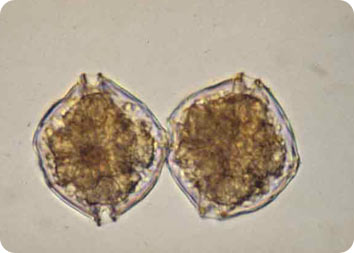The marine organism known as Alexandrium tamarense looks harmless enough. Its microscopic body is round or walnut-shaped, and is generally colored brownish-orange. Get enough of these little guys together, though, and you’ve got big trouble.
 Alexandrium tamarense cells. Credit: Woods Hole Oceanographic Institution / Don Anderson
Alexandrium tamarense cells. Credit: Woods Hole Oceanographic Institution / Don AndersonAlexandrium creates what scientists call “harmful algal blooms,” which often lead to red tides. Here in the United States, Alexandrium is found on both the Atlantic and Pacific coasts.
It’s not just a problem of aesthetics, though. Alexandrium produces powerful toxins that can contaminate shellfish like oysters and clams. And anything that eats a contaminated shellfish can get sick or even die -- including people.
But there could be a solution: mating toxic strains of Alexandrium with non—toxic strains.
In nature, these two varieties are never found together. But a team of American and British researchers recently crossed toxic and non-toxic varieties in the lab. In more than 200 experiments, the results of these unions didn’t survive -- there was a barrier that didn’t allow the two strains to reproduce. In fact, that may be why toxic and non-toxic strains aren’t found in the same place -- mating would kill them off.
And in the future, perhaps we can do just that. Although a lot more work is needed to make it work, non-toxic strains could be introduced to waters where toxic strains are common, just as sterile flies are used to get rid of damaging fruit flies in California. Then, when Nature follows its course, the toxic Alexandrium could disappear.

